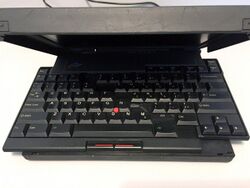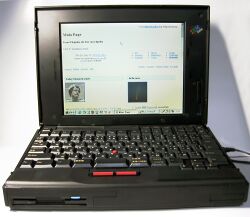 | |
.png) | |
| Subnotebook | |
| Manufacturer | IBM |
|---|---|
| Introduced | 6 March 1995 (720MB disk versions in September) |
| Discontinued | End of 1995 |
| Cost | $1,499 - $3,299 |
| Processor | Intel DX2, Intel DX4 |
| Frequency | 25–75 MHz |
| Memory | 4–40 MB |
| Power consumption | 30 Watts |
| Weight | 4.96 lb (2.25 kg) |
| Dimensions | 9.7 × 7.9 × 1.7″ |
The IBM ThinkPad 701 is a subnotebook series from the ThinkPad line by IBM consisting of the 701C and 701Cs models based on the Intel 486. The 701 is colloquially known as the Butterfly due to its sliding keyboard, which was designed by John Karidis. It was developed from 1993 and sold from March 1995 until later that year and priced between $1,499 and $3,299. The 701 was the most sold laptop in 1995 and has received 27 design awards. The 701 was discontinued because the keyboard design was no longer a necessity after screen sizes increased.
Background
The 701 was a collaboration project between the manufacturing facility at the Research Triangle Park near Raleigh, North Carolina in the US and the development facility at IBM Yamato in Japan. The concept of the keyboard was first developed as a photocopy of a keyboard in spring 1993. In the summer, a plexiglass prototype was developed. The decision to fund the notebook was made in the fall of 1993, with the introduction planned a year later. Because the process was delayed, it used the Intel 486 instead of the faster Pentium when it was released.[1] The keyboard was designed by with John Karidis,[2] Sam Lucente and Robert Tennant. Richard Sapper has been responsible for the overall ThinkPad design.[3] Other contributors include Lawrence Stone, Michael King, Martin Tucker and Gerard McVicker.[4]
Naming
The 701 was codenamed butterfly internally at IBM, and engineers also wanted to use this name as the official one. The IBM legal department did not allow the name of living creatures for products. It was part of the subnotebook series like the ThinkPad 500, but they did not want to attach the same name to this model due to bad sales of the previous 500 model. The 600 series was a reserved name, so they used the 700 series which was intended for the high-end models.[1]
Marketing
IBM bought advertising space in major newspapers, in the lower corner or on the upper right side of a page. They only used an image of a butterfly without anything else. Days later, they added the IBM logo with a butterfly icon.[clarification needed] A couple of days later, the text "Watch for the announcement" was added.[1]
After the announcement, IBM received a legal threat about the usage of the name "butterfly" by someone known only as George, as it violated their company's trademark on a supercomputer product named Butterfly. IBM replied that they did not plan to use it as a brand name, and no legal action or further correspondence took place.[1]
Specifications
The subnotebook series was released in different variations, with either the Intel DX2 or Intel DX4, LCD with dual scan or TFT active matrix. They were sold with different disk sizes. They all contained the same graphics chips and preinstalled software, except for the DX4 versions which were dual booted with IBM OS/2. It was based on the AT bus and could be extended with a Dock II type.[5]
| 701Cs[5] | 701C[5] | |||||||||
|---|---|---|---|---|---|---|---|---|---|---|
| Display | VGA color 640x480, dual scan, 10.4", 65k colors, 20:1 contrast | VGA color, 640x480, TFT active matrix, 65k colors, 100:1 contrast | ||||||||
| CPU | Intel DX2 50/25 MHz | Intel DX4 75/25 MHz | Intel DX2 50/25 MHz | Intel DX4 75/25 MHz | ||||||
| HDD | 360 MB | 540 MB | 360 MB | 540 MB | 720 MB | 360 MB | 540 MB | 360 MB | 540 MB | 720 MB |
| Retail price | $2,499 | $2,749 | $1,499 | $1,649 | $1,799 | $2,999 | $3,299 | $1,999 | $2,149 | $2,299 |
| Graphics | CT-65545, 1MB DRAM by Chips and Technologies on VL-Bus 2.0. External SVGA up to 1024x768 with 256 colors at 70Hz | |||||||||
| Operating systems | IBM DOS 6.3, Windows 3.11, DX4 machines included OS/2 Warp 3.0 in dual boot mode with selected BonusPack | |||||||||
| Pre-installed software | Lotus cc:Mail, Organizer, ScreenCam, PRODIGY, America Online, Video for Windows 1.1 Runtime, Audiofile TalkWorks | |||||||||
Keyboard
Officially known as the TrackWrite, but commonly known and code-named as the butterfly keyboard, is a foldout laptop computer keyboard designed by John Karidis for IBM.[6] It allowed the 701 series to be both compact (when closed) and comfortable to use (when open), despite being just 24.6 cm (9.7 in) wide with a 26.4 cm (10.4 in) VGA LCD.[1]
The butterfly keyboard is split into two roughly triangular pieces that slide as the laptop's lid is opened or closed. As the lid is opened both pieces slide out to the sides, followed by one piece sliding downward. The two halves mesh to form a keyboard 29.2 cm (11.5 in) wide which overhangs the sides of the laptop body. Conversely, as the lid is closed one piece slides back, then both slide inward until the keyboard can be covered by the lid. The movement of the keyboard is driven by a cam on the lid's hinge, so the motions of the keyboard parts are always synchronized with the movement of the lid.[1]
Reception
In a 1995 review of the 701C by InfoWorld the full-sized keyboard, large matrix screen and built-in multimedia features were positively noted. The nonstandard I/O ports were seen negatively.[clarification needed][7] The ThinkPad 701 has received 27 design awards, including the "Good Design Award" from CES Innovation and "1995 Product of the year" in the subnotebook category from InfoWorld.[1][8] Domus noted in a 2019 article that: "Even today, this portable PC amazes anyone who sees it open and close, and more than twenty years have gone by.".[9] The 701C was the top selling laptop of 1995.[10] Walt Mossberg considered it the most unusual and clever laptop he ever reviewed.[11] Clint Basinger from Lazy Game Reviews considered it one of the least enjoyable ThinkPads to use due to limitations but also noted that the keyboard is very satisfying to look at and show off.[12] The laptop is still popular with collectors, 26 years after its release.[13]
According to John Karidis, the IBM ThinkPad 700 succeeded because of the large screen size and full-sized keyboard, while other companies cramped their keyboards and failed. Karidis observed that the limiting factor in the laptop size was the keyboard width and that the screen and keyboard surface were equal with different aspect ratios.[1]
The laptop is being displayed in the design collection of the Museum of Modern Art in Manhattan, New York, Die Neue Sammlung in Munich, Germany [9] and in the Computer History Museum.[14] The ThinkPad 701 was briefly shown in 1995 James Bond film GoldenEye,[8] Blood Diamond and Mission: Impossible.[15]
Discontinuation
The 701 series was discontinued on 21 December 1995.[16] This was due to newer laptop models containing larger screens, so the laptop could contain a full sized keyboard without a folding mechanism. Other companies were also moving to Pentium processors.[1][17] The 701 series has been described as a product that had innovative features that were well received in the market, but the total package missed the competitive mark.[1]
Further developments
A few months after the release of the 701, the ThinkPad 760 was released which is based on the original Intel Pentium processor.
In 2014 it was reported by Hackaday that it was possible to desolder the original Intel DX4 and replace it with a faster Am5x86.[18]
Modern version
In 2003, ZDNet reported that the IBM Design Center was experimenting with new laptop models that included a butterfly keyboard.[19] David Hill stated that he tried to bring back the butterfly design, but was not able to do so.[20] In 2021, Lenovo has filed a patent for a keyboard that is similar to the one used in the 701.[21]
After the release of the Lenovo ThinkPad 25th Anniversary Edition in 2017, Antonio Villas-Boas from Business Insider has argued that Lenovo (who took over the ThinkPad line from IBM) should also bring back the butterfly keyboard design.[22]
See also
References
- ↑ 1.0 1.1 1.2 1.3 1.4 1.5 1.6 1.7 1.8 1.9 Dell, Deborah
- ↑ "Shaping the evolution of the PC - CNET News". 2011-06-16. http://news.cnet.com/2009-1082-270234.html.
- ↑ "Sam Lucente, John Karidis, Robert P. Tennant, Richard Sapper, IBM Corporation. ThinkPad 701 Portable Computer. 1995 | MoMA". 2015-11-09. https://www.moma.org/collection/works/2168.
- ↑ "The People Behind The Most Innovative Laptop Designs" (in en). https://www.pcmag.com/news/the-people-behind-the-most-innovative-laptop-designs.
- ↑ 5.0 5.1 5.2 Personal Systems Reference IBM ThinkPad Notebooks 1992 to 2001 - withdrawn: January 2001 - Version 214. IBM. 2001. pp. 53. https://psref.lenovo.com/syspool/Sys/PDF/withdrawnbook/twbook.pdf. Retrieved 2021-05-08.
- ↑ Spooner, John G. (2001-07-20). "Shaping the evolution of the PC". CNET. http://news.cnet.com/Shaping-the-evolution-of-the-PC/2009-1082_3-270234.html.
- ↑ Capen, Tracey (1995-03-06). "First look: IBM's innovative new ThinkPad unfolds from subnotebook to laptop at your fingertips" (in en). InfoWorld (InfoWorld Media Group, Inc.): 1, 104. ISSN 0199-6649. https://books.google.com/books?id=hzoEAAAAMBAJ. Retrieved 2021-05-04.
- ↑ 8.0 8.1 Naitoh, Arimasa (2017). "Chapter 5: A Butterfly's Day in the Sun". How the ThinkPad changed the world: and is shaping the future. William J. Holstein. New York. ISBN 978-1-5107-2500-3. OCLC 992973085. https://www.worldcat.org/oclc/992973085. Retrieved 2021-03-25.
- ↑ 9.0 9.1 Lana, Alessio (2019-03-28). "IBM Thinkpad 701C, the 1995 "butterfly" laptop" (in en-gb). https://www.domusweb.it/en/product-news/2019/03/25/ibm-thinkpad-701c-the-1995-butterfly-laptop.html.
- ↑ Light, Larry (1996-02-19). "IBM's Butterfly On A Pin". Businessweek. http://www.businessweek.com/1996/08/b346311.htm.
- ↑ Patel, Nilay (2017-06-12). "Inside Walt Mossberg's gadget museum" (in en). https://www.theverge.com/2017/6/12/15779450/walt-mossberg-original-iphone-ibm-thinkpad-amazon-kindle-video.
- ↑ Basinger, Clint, "IBM ThinkPad 701C: The Iconic Butterfly Keyboard" (in en), Lazy Game Reviews, https://www.youtube.com/watch?v=nRVJCtREW38, retrieved 2021-07-24
- ↑ "How a toy inspired the ‘butterfly’ keyboard design of the iconic IBM ThinkPad 701C" (in en). 2021-06-14. https://indianexpress.com/article/technology/laptops/how-a-toy-inspired-the-butterfly-keyboard-design-of-the-iconic-ibm-thinkpad-701c-7356741/.
- ↑ "Computer History Museum" (in en-gb). 2011-01-12. https://uk.pcmag.com/laptops/58419/computer-history-museum.
- ↑ "Starring the Computer - IBM Thinkpad 701". http://www.starringthecomputer.com/computer.html?c=205.
- ↑ "Discontinued Thinkpads". https://groups.csail.mit.edu/mac/ftpdir/thinkpad/old-archive/HTML/tp-1995/msg03135.html.
- ↑ Mitchell, Robert L. (2011-01-07). "Flashback: What killed IBM's Bufferfly" (in en). https://www.computerworld.com/article/2470091/flashback--what-killed-ibm-s-bufferfly.html.
- ↑ Fabio, Adam (2014-10-21). "Thinkpad 701c: Reverse Engineering A Retro Processor Upgrade" (in en-US). https://hackaday.com/2014/10/21/thinkpad-701c-reverse-engineering-a-retro-processor-upgrade/.
- ↑ Kidman, Angus. "Butterfly notebook may spread wings again" (in en). https://www.zdnet.com/article/butterfly-notebook-may-spread-wings-again/.
- ↑ Piltch, Avram (October 2017). "25 Years of ThinkPad: The Best and Most Innovative" (in en). https://www.laptopmag.com/articles/best-thinkpads-of-all-time.
- ↑ Murphy, Darragh (2021-07-15). "Lenovo may bring back a classic foldable ThinkPad laptop keyboard" (in en). https://www.laptopmag.com/news/lenovo-may-bring-back-a-classic-foldable-thinkpad-laptop-keyboard.
- ↑ Villas-Boas, Antonio. "This 22-year old ThinkPad had an amazing pop-out keyboard that was way ahead of its time". https://www.businessinsider.com/lenovo-thinkpad-701c-laptop-butterfly-keyboard-2017-10.
Book sources
- A. Dell, Deborah; Purdy, J. Gerry (2000). "Butterfly: A Hit That Missed". ThinkPad: a different shade of blue. Sams Publishing. pp. 321. ISBN 0-672-31756-7. OCLC 502997994. http://worldcat.org/oclc/502997994.
External links
- Hardware maintenance manual
- Patent US6262881B1 - Compact notebook computer with movable keyboard section
- Official website - IBM.com
- Craig's IBM Butterfly Page
- The Butterfly (in Japanese)
- "IBM ThinkPad Butterfly, 360 degree model", Russian Vintage Laptop Museum, http://vintage-laptops.com/?page_id=296&lang=en
- Commercial by IBM
- Japanese IBM ThinkPad 701C brochure
- Battery replacement guide
- Remembering the ThinkPad 701C
- IBM Thinkpad 701C Factory Restore Disk Image with OS/2 Warp and Windows 3.1
- IBM ThinkPad 701C, Complete Restoration!
| Preceded by IBM ThinkPad 500 |
IBM ThinkPad 701 | Succeeded by IBM ThinkPad 760 |
 |



